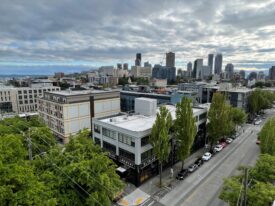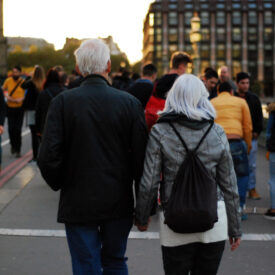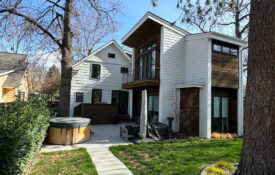A growing body of research shows that walkable, compact communities can promote good health and a healthier planet by promoting exercise and reducing the risk of obesity; lowering car crash fatalities; reducing greenhouse gas emissions and vehicle-related air pollution; and cutting down gasoline bills and oil imports.
Walkable Communities are Climate-Friendly
- Cars and trucks are the Northwest’s single largest source of climate-warming emissions. Compact, walkable neighborhoods allow families to make fewer trips in their cars, travel less to meet their everyday needs – and thus reduce their contribution to global warming.
- The air in your car may be some of the worst you’ll breathe all day. Busy highway traffic turns roadway air into a “tunnel of pollution,” exposing drivers to high levels of benzene, fine soot, volatile organic compounds (VOCs), and other pollutants from vehicle exhaust. (Rank, Jette; Folke, Jens; Jespersen, Per Homann. “Differences in Cyclists and Car Drivers Exposure to Air Pollution from Traffic in the City of Copenhagen” The Science of the Total Environment 2001; v.279; pp.131-136.)
Walkable Neighborhoods Promote Safety
- Residents of sprawling neighborhoods drive longer distances, and spend more time overall in their cars, than do residents of more compact neighborhoods. All else being equal, the more one drives, the greater one’s risk. (NHTS; Victoria Transport Policy Institute, “Safe Travels: Evaluating Mobility Management)
- King County—the most urbanized county in Washington—has the lowest overall crash risk of any county in the state.
Walkable Neighborhoods Give You Time Back!
- Walking 30 minutes a day, five days a week, adds 1.3-1.5 years to your life, on average. This means that for every minute you spend walking, you get three back.
- People who live in the most-walkable neighborhoods are 2.4 times as likely to walk for 30 minutes or more than those who lived in the least-walkable communities.
- Residents of traditional neighborhoods, with good pedestrian facilities and stores and services just a short walk from people’s homes, get 70 extra minutes of physical activity per week, and are 40 percent less likely to be overweight or obese than residents of sprawling neighborhoods. (Brian E. Saelens, “Neighborhood-Based Differences in Physical Activity: An Environment Scale Evaluation,” American Journal of Public Health, Sept. 2003, v.93, n.9)
Also see:
- What’s Walkable?
- Sprawl and Health Connections
- The Research: Studies on Health and Sprawl
- Posts on Sightline Daily about Walkscore, which rates cities and neighborhoods for walkability







